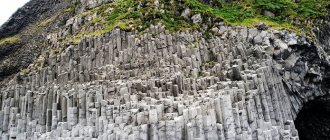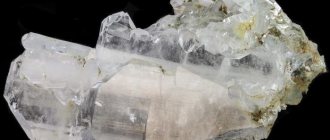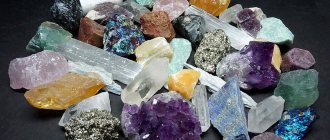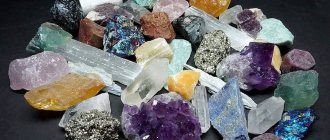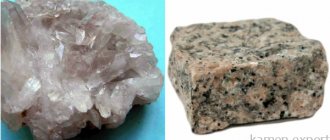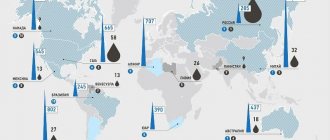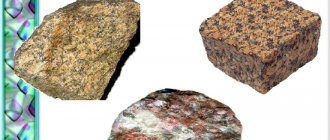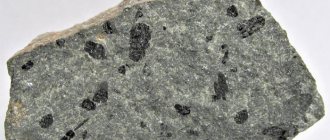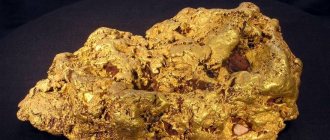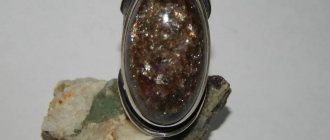What it is
Metamorphic rocks are rocks formed in layers of the earth's crust due to the process of metamorphism (that is, the transformation of igneous and sedimentary rocks under the influence of physicochemical conditions). Based on the first type of rocks, a form of intrusion (cover) is formed. In this case, the prefix ortho- is added to the name of the rock, for example, orthogneiss. Sedimentary rocks give a layered form of occurrence, while the prefix para- is added to the name of the rocks, for example, paragneisses.
General definition and types
Previously, the concept that we use now did not exist until the mineralogist and geologist, Vasily Mikhailovich Severgin, introduced the phrase “rock” in 1798. They are a collection of minerals formed inside the bowels or on the surface of the Earth. They are used as a base material for construction. On the economic side, they are minerals.
The science that studies the origin of rocks, their structure, and features is called petrography. According to scientific data, rocks are divided into:
- sedimentary: from water and air components (10% of volume);
- igneous: from melted mass, that is, magma;
- metamorphic or secondary.
Metamorphic and igneous formations occupy most of the volume of the lithosphere - 90%.
Now we will analyze in detail the third type, how it is formed, its structure, types, characteristic features.
What is metamorphism
Metamorphism is the process of transforming rocks while maintaining a solid state. It occurs under the influence of endogenous factors. How are metamorphic rocks formed and what influences this process? The main factors of this phenomenon: pressure, temperature, chemically active substances.
How does temperature affect metamorphic rocks? It triggers the processes of mineral formation and accelerates the occurrence of chemical reactions: dehydration and decarbonization. As a result, higher temperature metamorphic rocks are formed - minerals that do not contain water.
Pressure in endogenous conditions is comprehensive and directional. Comprehensiveness is achieved due to the fact that there is a load on the overlying strata, lateral pressure from neighboring blocks and layers of the Earth that lie below. An increase in pressure leads to the formation of rocks of metamorphic origin - minerals with a very dense, uniform structure and a higher melting point.
The process of metamorphism also involves water and carbon dioxide - chemically active substances. They are found in the pores of almost all rocks. Hydrochloric and hydrofluoric acid, hydrogen sulfide, and nitrogen are also present. Chemically active substances, being in a liquid or gaseous state, move from zones with high pressure and temperatures to zones of low pressure.
Types of metamorphism
To better understand how metamorphic rocks are formed, it is worth considering the main types of this phenomenon. Based on the manifestation of any factors, the following are distinguished:
- Dynamometamorphism (dislocation, cataclastic) – occurs under conditions of stress (directional pressure).
- Isochemical - metamorphic rocks do not change in chemical and gross composition.
- Metasomatic (allochemical) - the bulk composition of the rock changes (some substances are removed, while others, on the contrary, are added).
- Thermal (contact-thermal) - carried out under the influence of the heat of cooling magma. High-temperature minerals are formed deep in the earth's crust, and low-temperature minerals form as they move away from the magmatic layer.
- Regional – carried out in large blocks of the earth’s crust under the influence of all the main factors (chemically active substances, pressure and temperature).
Classification of metamorphism according to impact factors
The most modern classification of metamorphism is as follows:
- Immersion metamorphism occurs when the circulation of aqueous solutions increases under the influence of pressure.
- Hydration – interaction of aqueous solutions with rocks.
- Impact metamorphism - powerful endogenous explosions or falls of large meteorites.
- Dislocation – various tectonic deformations.
- Thermal – with an increase in temperature.
Test on the topic
- /5
Question 1 of 5What state do rocks find themselves in after metamorphism?
Start test
Hall of Fame
To get here, take the test.
- Zheka Kortashov
5/5
- Masha Berezhnaya
5/5
- Andrey Kanashev
4/5
Metamorphic rocks: examples of composition
The chemical composition of these rocks is quite diverse and depends primarily on the composition of the initial components. Of course, the chemical composition may differ from the original one, since substances are exposed to metasomatic processes.
Metamorphic rocks have a diverse mineral composition. The list of rock-forming minerals can be quite long: quartz, feldspars, amphiboles, micas, pyroxenes. Typical metamorphic minerals such as kyanite, sillimanite, andalusite, garnet, scapolite, and cordierite are also present. The substance from which metamorphic rocks can be entirely composed is marble (calcite). Slightly metamorphosed rocks are characterized by the presence of chlorites, talc, zoisite, epidote, actinolite, and carbonates.
Metamorphic rocks and autometamorphism
Metamorphic rocks include rocks formed in layers of the earth's crust during the process of metamorphism (the name means “transformation”; this is the modification of igneous and sedimentary rocks under the influence of physicochemical phenomena). The initial state forms the corresponding form of occurrence (igneous rocks form intrusions, or orthogneiss; sedimentary rocks - sheet forms, or paragneisses).
Autometamorphism is the process of reincarnation of noble breeds . It occurs under the influence of magmatic conditions. Main influences: pressure, temperature, chemical elements. The formation of minerals begins at high temperatures, while at the same time the chemical actions of dehydration and decarbonation are accelerated. As a result, pyrogenic metamorphic noble rocks arise - minerals devoid of liquid.
The influence of magmatogenic circumstances is multilateral and oriented. Versatility arises due to the load of higher strata, side effects are exerted by nearby blocks and layers of the Earth lying below. An increase in pressure leads to the formation of noble minerals of metamorphic origin - minerals with a concentrated, uniform texture and a rather high melting point.
In addition, liquid and carbon dioxide, the active elements, take part in the process of metamorphism. They are present in the pores of almost all minerals. It also contains hydrochloric and hydrofluoric acid, fuel, and nitrogen.
Electrochemical active substances, being in watery or gaseous form, move from places of high pressure to places of low pressure.
Main types and conditions of influence
In order to understand how rocks arise, it is necessary to analyze the main types of this impact. There are several types of metamorphic minerals. List of varieties depending on the method of formation:
- Dynamometamorphic (dislocation, cataclastic) - occurs as a result of stress (targeted pressure).
- Isochemical - with it, fossils do not change their characteristics in any way.
- Metasomatic (allochemical) - the rubble composition changes (some elements are removed, and some are added).
- Thermal (contact-thermal) - occurs under the influence of the heat of magma. In the middle of the earth's crust, minerals appear with an increased temperature, and with a distance from the cover - with a lower temperature.
- Regional - takes place in large blocks of the earth's crust under the influence of all key conditions (functioning elements, pressure and temperature).
The specification of metamorphism can be divided according to the conditions of influence. The most modern is the division into:
- Immersion autometamorphism - appears as a result of an increase in the circulation of water elements under the influence of pressure.
- Hydration metamorphism is the connection of a liquid with a mineral.
- Effective (impact) autometamorphism - strong magmatic explosions or the decline of large meteorites.
- Dislocation - various deformations.
- Thermal - with a change in temperature.
The chemical structure of these rocks is quite diverse and initially depends on the structure of the initial elements. Of course, the chemical composition differs from the initial one, since the elements are influenced by metasomatic actions. Metamorphic rocks have a diverse mineral structure. Minerals forming rocks: silicon, spar, amphiboles, micas, pyroxenes.
In addition, characteristic metamorphic minerals may be contained, including kyanite, sillimanite, andalusite, garnet, scapolite, and dichroite. The element that metamorphic fossils are entirely composed of is granite (Iceland spar).
Slightly metamorphosed ones are characterized by the presence of chlorites, motok, zoisite, epidote, actinolite, and carbonates.
Structure and main composition
Metamorphic fossils can be classified according to variations in structure . Here are some ways to fill in texture space:
- Shale - especially common in metamorphic rocks. Adapts to crystallization at elevated pressure - it splits into small plates or tiles.
- Spotted - the mineral has spots that vary in composition, coloring and resistance to weathering.
- Banded - alternation in a mineral of various stripes, varied in composition, forming textures. This structure is found in magmatic, sedimentary, and metamorphic rocks.
- Curling - under the influence of high pressure, small folds are formed.
- Massive—there are no rock-forming minerals.
- Cataclastic - minerals are recognized by alteration and separation, and grains are set.
- Amygdaloid, tennantite, is represented by relatively oval or rounded apparatuses between the schistose rock mass.
Composition determines the dimensional characteristics of the grains that form the rock. Textures appear when crystallized in a rigid form.
Absolutely all metamorphic rocks are characterized by their own unique structure, which is unusual for other types of minerals. The list is classified depending on the volume and shape of mineral grains.
Rock textures
We classify metamorphic rocks. Examples of textures will give an idea of the spatial characteristics of the properties of a particular rock. The following methods of filling texture space are distinguished:
- Shale is most common in metamorphic rocks. Lamellar, leafy and scaly minerals have this texture. It is believed that this is a kind of adaptation to crystallization at high pressure - the rocks break up into thin plates or tiles.
- Spotted - the rock has spots that differ in composition, color and resistance to weathering.
- Banded - the mineral alternates bands of different composition. Igneous, sedimentary, and metamorphic rocks have this texture.
- Flat - under the influence of high pressure, the rock gathers into small folds.
- Massive – there is no orientation of rock-forming minerals.
- Cataclastic - minerals are characterized by deformation and fragmentation, grains are formed.
- Almond stone - the mineral is represented by relatively oval or round aggregates among schistose rocks.
Classification system
There are a huge number of types of rocks, divided into groups. Genetically distinguished:
- sedimentary;
- metamorphic;
- igneous.
The latter are further divided into three classes:
- plutonic;
- hypabyssal;
- volcanic.
Subgroups can be divided into:
- sour;
- average;
- basic;
- ultrabasic.
It is almost impossible to compile a complete list of rocks, taking into account all the species existing on Earth, there are so many of them. In this article, we will make an attempt to structure information about the most interesting and frequently occurring types.
Structure of metamorphic rocks
This concept characterizes the dimensional parameters of the grains that form the rock. The structures arise during crystallization in the solid state. All metamorphic rocks have their own unique structure. The list can be classified according to the size and shape of the mineral grains. Based on the shape of the grains, the following structures are distinguished:
- fibroblastic (fibrous crystals);
- nematoblastic (needle-shaped and long-prismatic crystals);
- lepidoblastic (scaly or leafy crystals);
- granoblastic (isometric grains).
By relative size we can distinguish:
- heteroblastic (all grains of different sizes);
- homeoblastic (grains of the same size);
- porphyroblastic (unevenly granular);
- sieve (in large crystals of a mineral small ingrowths of another mineral are observed);
- poikiloblastic (small growths of various minerals at the base of the rock).
Rocks of regional metamorphism
As a result of regional metamorphism, the following rocks were formed:
- Phyllites are a dark, dense, schistose rock with a peculiar silky sheen. It consists of sericite and quartz, with possible admixtures of biotite, chlorite and albite.
- Clay shales are rocks that represent the initial stage of metamorphism of clayey rocks. They consist of chlorite, hydromica, less commonly – kaolinite, mixed-layer minerals and montmorillonite. It also contains quartz, feldspars and various non-clay minerals. These rocks got their name due to their schistose structure. They are fairly easy to break into tiles. The color is brown, gray, green. May contain carbonaceous matter, iron sulfides and carbonate formations.
- Talc slates - consist of flakes or leaves of talc with a shale structure. The mineral is soft, has a greasy sheen, and is white or greenish in color. The composition may contain chromite, magnesite, apatite, actinolite, tourmaline, and glinkite as impurities. Quite often, chlorite is mixed with talc, which causes the transition to talc-chloride shale.
- Crystalline schists are a large group of metamorphic rocks that are distinguished by a high degree of metamorphism. They consist of quartz, feldspars, dark-colored minerals, the quantitative relationships between which may be different.
- Quartzites are rocks consisting of quartz grains. They are formed during the metamorphism of porphytes and small sandstones. They are a kind of “search beacon” for finding deposits of copper pyrite ores.
- Chlorite shales are scaly or shale rocks that consist predominantly of chlorite with an admixture of mica, talc, actinolite, quartz, and epitode. They are greasy to the touch, slightly hard and green in color.
This is by no means a complete classification of metamorphic rocks of regional metamorphism. Amphibolites and gneisses are also distinguished.
Categories
The transformation of aggregates manifests itself in different ways, this is determined by nature and territory. Scientists note local and regional metamorphisms.
The first type manifests itself at great depths, where high temperature conditions, force intensity and chemical compounds operate in the same mode. The result of such work is immense blocks of folded metamorphic rocks. Rocks that have undergone regional metamorphism are divided into:
- low-temperature, the temperature of which is 300-500 degrees;
- medium temperature (500-600 degrees);
- high temperature (above 650 degrees).
Metamorphism becomes progressive if it leads to the creation of mineral aggregates with a higher temperature, and regressive if it leads to a decrease in degrees.
Rocks often experience ultrametamorphism, when the intensity of transformation in the deep layers reaches its limit, melts come into force. As a result, the rocks melt completely or partially.
Now let's move on to the second type. Local metamorphism occurs in small areas and is divided into:
- contact (changes occur in rock minerals due to the heat of the magmatic body (intrusive) and fluids). As a result of this process, rocks such as hornfels arise. If the composition of the substance has undergone significant transformations, then the rocks have undergone contact-metasomatic change .
- cataclastic or dynamometamorphism occurs due to targeted pressure that causes rock cataclasis. This transformation covers places with tectonic movement.
Basic metamorphic rocks
| Coloring | Main mineral composition | Diagnostic signs | Breed |
| Pied Banded | Feldspar, quartz, mica (usually biotite), hornblende, pyroxenite | Dense, streaky or spectacled texture. The mineral composition is similar to that of granite | Gneiss (orthogneiss is formed from igneous rocks, paragneiss from sedimentary rocks) |
| White, pink, yellowish, brown, etc. | Quartz and impurities | High hardness (7), greasy shine, sometimes conchoidal fracture | Quartzite |
| White, gray, yellow, orange, yellow, red, etc. Sometimes with veins of a different color | Calcite, dolomite to admixture | Crystal structure, reaction with hydrochloric acid of a sample (calcite) or powder (dolomite) | Calcite or dolomite marble |
| Silver gray or dark gray | Muscovite, sericite, quartz, biotite | Slate dense texture, abundance of mica | Mica slate |
| Dark green | Chlorite and impurities (talc, etc.) | Slate texture, predominance of dark green color | Chlorite shale |
| Light green to white | Talc to impurities (chlorite, etc.) | Slate texture, predominance of scaly, oily talc to the touch | talc slate |
| Dark, black | Graphite and impurities | Slate texture, predominance of graphite with a metallic luster | Graphite slate |
Rocks formed during dynamometamorphism
They arose under the influence of tectonic disturbances in the zone of fragmentation and deformation, to which not only the rock itself, but also the minerals are subjected. The following types are distinguished:
- Monoliths are finely ground rocks with a clearly defined slate structure. Such minerals are formed in crushing zones, along fault and thrust planes. Individual blocks of rocks move, which leads to crushing, grinding and simultaneous compression of the rock, due to which it becomes homogeneous and compact. A characteristic feature of monoliths is a banded structure, fluidity and stratification.
- Cataclasites are formed as a result of dislocation metamorphism, which is not accompanied by the phenomena of mineral formation and recrystallization. In the internal structure, highly deformed, bent and crushed mineral grains and binder cement can be observed.
Origin of monoliths and cataclysites
Dynamometamorphisms occur due to the influence of tectonic errors in the area of separation and alteration of minerals. There are two varieties of it:
- Monoliths are ground rock with a distinct slate texture. Similar minerals appear in places of separation. Single blocks of rocks move and lead to separation, grinding and synchronous compression, ultimately becoming homogeneous and small-sized. Distinctive features of monoliths are stripes, fluidity and separation.
- Cataclasites appear as a result of dislocation metamorphism, not accompanied by the actions of mineral formation and recrystallization. Inside you can find highly modified, curved and separated mineral seeds.
Metamorphic fossils are used all over the world for their decorative, ornamental and construction functions, and are used as industrial raw materials. In nature, they are most often found near deposits of ornamental and precious stones.
